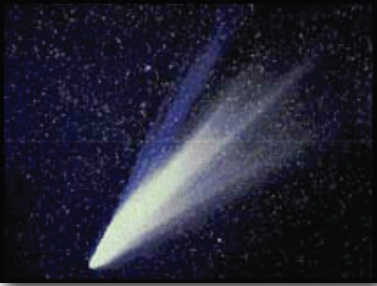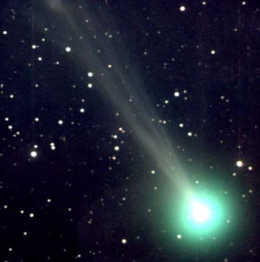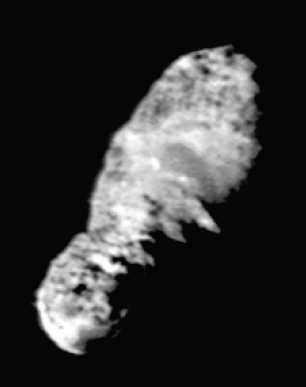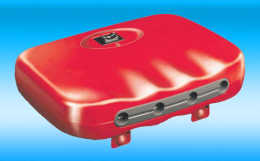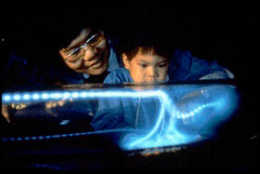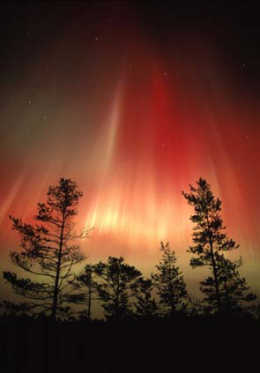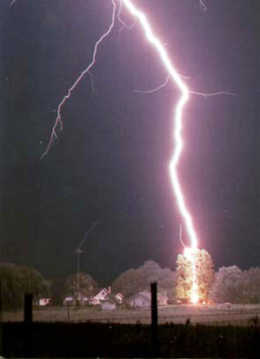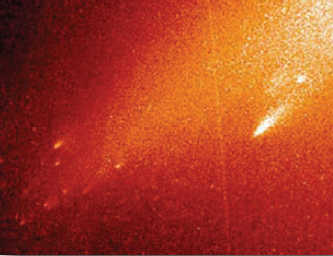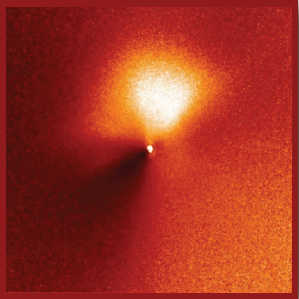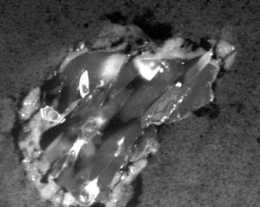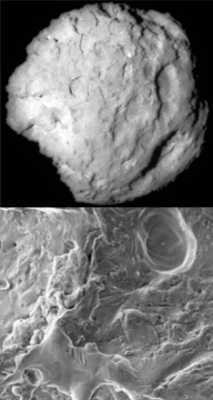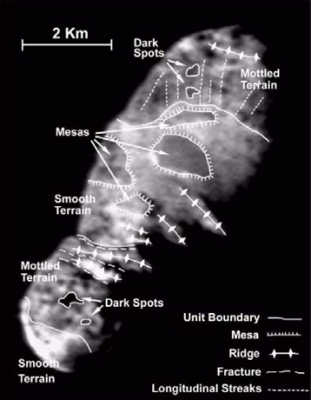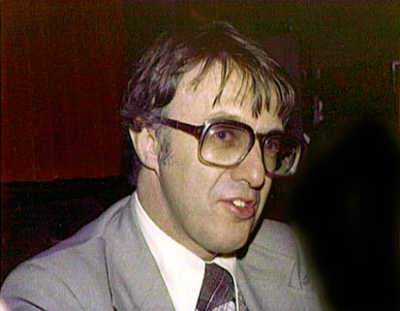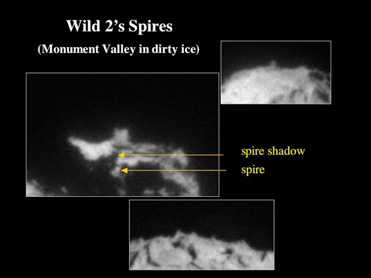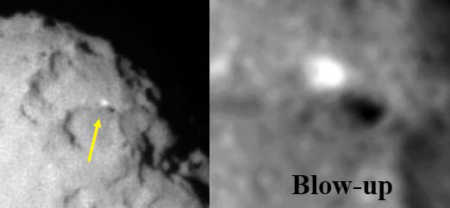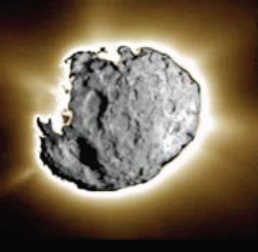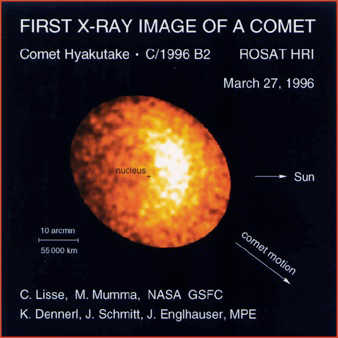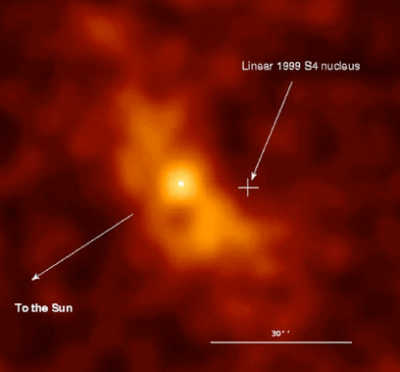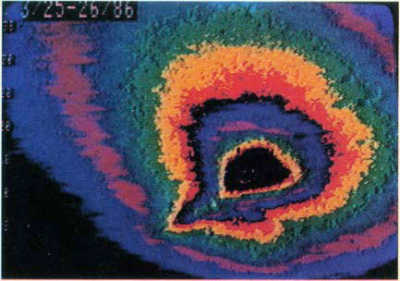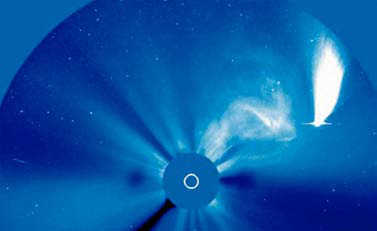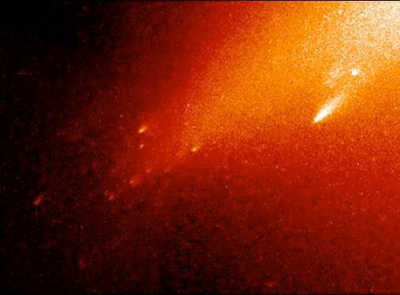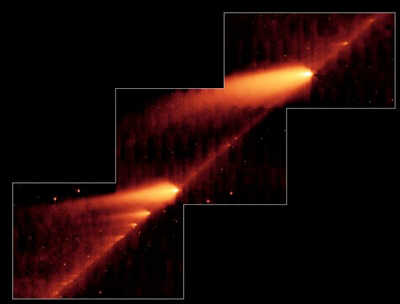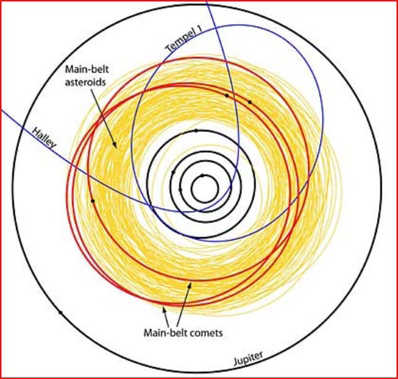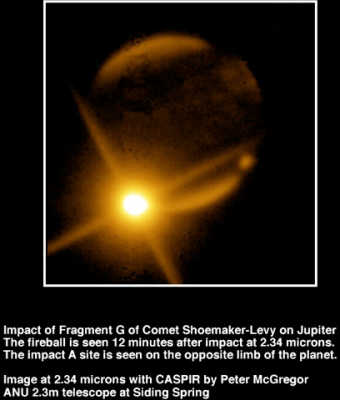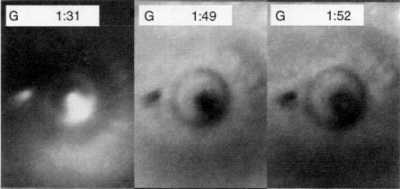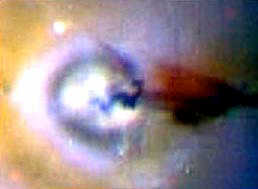Excerpts From The Electric Universe
Electric Comets Part 1
The following is the first of a series of excerpts from The Electric Universe, copyright © 2002, 2007 Wallace Thornhill and David Talbott and published by Mikamar Publishing. Reproduced with the kind permission of the authors and publisher.
Presented by Dave Smith |
| |
| January 16, 2010 |
| |
| Since the beginning of the space age and with progression to more sophisticated and accurate space probes and telescopes, astrophysicists have been presented with many "surprises", resulting in an almost daily ad hoc adjustment of their theories. But of the many bodies known throughout space, nothing is more enigmatic for the standard model of cosmology than the humble comet. And so we begin this presentation at the beginning of Chapter 4, Electric Comets.
Page 85:
Chapter 4 - Electric Comets
“Comets are perhaps at once the most spectacular and the least well understood members of the solar system.”
–Marcia Neugebauer, JPL
At the end of the nineteenth century neither an electric Sun hypothesis nor a theory of electric comets would have been controversial. Both were discussed in scientific papers. Around the same time, Kristian Birkeland performed his electrical Terrella experiments, reproducing the behavior of sunspots and auroras.91
Then science took a wrong turn. Investment in a theory began to override critical attention to observation and to experimental testing of alternatives. Astronomers shunned Birkeland, whose work posed new and promising possibilities. Not until the latter half of the 20th century did innovative scientists again consider electrical explanations, concentrating their investigations in the fields of electrical engineering and plasma science, rather than astrophysics. Alfvén devoted chapters in his 1981 book Cosmic Plasma,92 to the electric circuits of the Sun, planets, and comets. But still, few astrophysicists were listening.
Each time a comet is observed close up, we are told that our understanding of comets and the origin of the solar system will be revolutionized. But the revolution never happens. The established story about comets has become an article of faith.
|
| |

In 1950, Fred Whipple proposed a model of comets that became
famously known as the "dirty snowball" hypothesis.
Photo Smithsonian Astrophysical Observatory, courtesy Dr. Whipple
[Click to enlarge]
|
| |
The French artist Georges Braque suggested that it is always useful to have two ideas, one to challenge or dispose of the other. Astronomers have only a singleidea about comets, and the lack of competition encourages behavior that is more interpretive than investigative. In the absence of skepticism, intellectual curiosity gives way to conformity and conceit, as when NASA inscribed the words of Fred Whipple, the originator of the ‘dirty snowball’ comet model, on a microchip carried by the Stardust spacecraft in 2004: “Today we know that comets are black and cold, consisting of ices and dust that coalesced from an interstellar cloud as it collapsed to form the solar system.” We know no such thing.
We have never observed an interstellar cloud collapsing to form a planetary system. And no gravitational accretion model has been able to explain the weird assortment of solar planets. Dusty rings and disks around stars have been discovered, but it is pure conjecture to call
Page 86:
them ‘gravitational accretion’ disks, since we also observe those stars ejectingmatter in defiance of gravity.
|
| |

Of all the bodies in the heavens, perhaps none will prove more definitive
in confirming the electric field of the Sun than the comet.
Image Credit: NASA
[Click to enlarge]
|
| |
If comets are dirty, icy leftovers from the primordial formation of the planets, why are the nuclei so black? Why does comet dust show minerals expected to have formed at high temperatures near the Sun? How does a tiny comet nucleus produce a finely filamented plasma tail that stretches for tens of millions of kilometers across the solar system? If the tail is formed of matter evaporated from the comet by the Sun’s heat, why is the matter ejected in energetic jets? And why do comet nuclei present us with such sharply carved relief, when the surface was supposed to look like a softened ice cream melting in the Sun? The questions are legion, while the ‘explanations’ invariably come after the fact and as disconnected guesses. Yet seldom is the popular myth of comet origins questioned.
By all appearances comet nuclei appear to be complex, cratered rocks a few kilometers in diameter. All that seems to distinguish them from those other space mountains—asteroids—is their eccentric orbits and accompanying displays in the heavens. Indeed, we now know that some asteroids occasionally exhibit cometary comas. One schizoid object, Chiron, is classified a ‘Centaur,’ named after a mythological figure that was half man, half horse. This, of course, refers to the ‘half and half’ (comet/asteroid) nature of Chiron. Yet rocky asteroids were thought to be much more evolved bodies than comets, and no one had imagined that the distinction between comets and asteroids would break down as it has in recent years.
Space age attempts to determine the composition and structure of comets have, in fact, left Whipple’s dirty snowball model in disarray. Infrared spectra of several comets have shown the presence of the mineral olivine, which requires a temperature of between 1,100 and 1,600 Kelvin and the absence of water, to form crystals. Such a temperature would have driven off any ices. So an ad hoc requirement was added—that the ‘hot’ and ‘cold’ components of a comet must be formed in separate regions of the primordial nebula and then later mixed together. Ironically, a similar problem of mixing high and low temperature components is found in meteorites, and in this case a few adventurous astronomers have attributed the enigmatic composition to the effects of lightningin the early solar nebula—an explanation at least pointing in the right direction.
Page 87: INFORMATION PANEL [ Permalink ]
Early Electric Theories of Comets
|
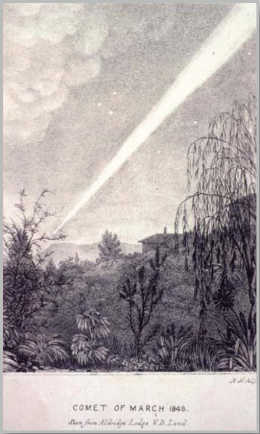
Professor W. Stanley Jevons wrote in Nature, December 28, 1871:
“The observed regular diminution of period of Encke’s comet is still, I believe, an unexplained phenomenon for which it is necessary to invent a special hypothesis, a Deus ex machina, in the shape of an imaginary resisting medium... It is asserted by Mr. R. A. Proctor, Prof. Osborne Reynolds, and possibly others, that comets owe many of their peculiar phenomena to electric action... I merely point out that if the approach of a comet to the sun causes the development of electricity arising from the comet’s motion, a certain resistance is at once accounted for.”
In July 1872, Scientific American informed its readers that “Professor Zollner of Leipsic” ascribes the “self-luminosity” of comets to “electrical excitement.” According to the article, Zollner suggests that “the nuclei of comets, as masses, are subject to gravitation, while the vapors developed from them, which consist of very small particles, yield to the action of the free electricity of the sun....” Also the August 1882 English Mechanic and World of Science wrote of comet tails: “...There seems to be a rapidly growing feeling amongst physicists that both the selflight of comets and the phenomena of their tails belong to the order of electrical phenomena.” Similar ideas about comet’s tails appear in Nature, Jan 30, 1896: “It has long been imagined that the phenomenon of comet’s tails are in some way due to a solar electrical repulsion, and additional light is thrown on this subject by recent physical researches.”
In 1924 Hugo Benioff published The Present State of the Electrical Theory of Comet Forms. Benioff noted that electrostatic repulsion of ionized comet tails required “a value of the solar charge which is over one hundred times larger than can be accounted for by any known ways of producing such a charge.”
The solar charge was positive and estimated to be 127 times greater than could be achieved by the escape of electrons from a hot Sun. Benioff concludes that “It would seem best therefore to attribute the Sun’s repulsive action on the tail particles to radiation pressure rather than to electrical action since the former has been shown to be adequate to account for the facts qualitatively at least.”
However, there is a vast gulf between what may work for a single phenomenon qualitatively and what must work for all phenomena quantitatively. Here we see how critical it is to choose the correct model before applying any mathematical analysis. When working with incorrect assumptions, mathematics merely “allows one to be wrong with confidence.”
Benioff admits “There are other phenomena associated with comets that indicate the presence of electrical forces. The outward radial motions in all directions of particles close to the nucleus are best explained as resulting from an electrical charge associated with the nucleus.” But once again, the model proposed for charging the comet nucleus is naïve and merely considers charging by photo-ionization. Science is supposed to advance by revisiting earlier assumptions in the light of new knowledge. Clearly, that has not happened.
|
Page 88:
Astronomers continue to attribute a comet’s star-like nucleus and gigantic glowing coma and filamentary tail to solar heating as it nears the Sun. But as far back as 1991, it was already apparent that something was wrong with such a simple solar heating model. Moving between the orbits of Saturn and Uranus—a distance fourteen times farther from the Sun than the Earth—Comet Halley inexplicably flared up. At that distance solar heat does not sublimate ices. But telescopes showed that the 15-kilometer nucleus had ejected a cloud of dust that stretched more than 300,000 kilometers. But under the inertia of official theory, such surprises are invariably minimized and quickly forgotten.
|
| |
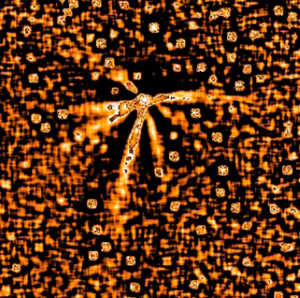
On its journey through the inner solar system, Comet Hale-Bopp began
discharging out past the orbit of Jupiter—too far from the Sun for a "snowball"
to melt. Four years after Hale-Bopp left the inner solar system,
it was still active. It displayed a coma, a fan-shaped dust tail,
and an ion tail— even though it was farther from the Sun than
Jupiter, Saturn or even Uranus.
Credit: N. Thomas (MPAE) et al., 1.5-m La Silla Telescope, ESO
[Click to enlarge]
|
| |
Repeatedly, astronomers have observed comets ejecting material in narrow jets of gas and very fine dust. Hale-Bopp emitted more dust than could be explained by subliming ices. Observations of comet jets by earth-based instruments and space probes since 1985 have revealed distinctive similarities to the discharge plumes from Jupiter’s moon, Io—though no astronomer is about to call Io a comet. And the surface of comet Tempel 1, viewed in one of our closest-ever looks at a comet nucleus, showed the same similarities to electric discharge machining (EDM) features that the Galileo probe revealed on the surface of Io.
The violent jets seen exploding from Comet Halley in 1985, like those of Comet Borrelly in 2001, were far more energetic than could be explained by sublimation of ice in the heat of the Sun. And close-up views showed that it is not the full sunward faces of cometary nuclei but well-focused discharge jets, some on the dark side, that produce the spectacular tails of comets.
The Origin of Comets [ Permalink ]
Because comets lose considerable material at each pass around the Sun, the ones we see cannot have been around for long. Of course more than one answer to this dilemma might have been proposed, but astronomers chose one theory in particular, and it has posed dilemmas ever since. They claimed that since the formation of the planets billions of years ago, comets have occupied the deep freeze beyond the solar system. There they form an invisible cloud of icy objects located about 1000 times farther from the Sun than Pluto, a good fraction of the way to the nearest star.
The imagined cloud is named after Jan Oort, the astronomer who proposed the idea. After billions of years, somehow a comet is deflected from the Oort cloud into the inner solar system. The disturbance is surmised to be due to a passing star or the movement of the Sun above and below the galactic plane. But many astronomers have pointed to the lack of evidence for sporadic comet showers that such disturbances should unleash, and they have concluded that such
Page 89:
events, if they do occur, could only account for about one-fifth of the comets we see.
Astronomer Tom Van Flandern has devised a scale model that demonstrates the implausibility of the Oort cloud theory.93 If the Earth’s orbit were represented by the period at the end of this sentence and Pluto’s orbit by a circle of one-centimeter diameter, then the nearest star is 41 meters away. The Oort cloud of comets would orbit near a sphere 6 meters in diameter containing one comet per cubic millimeter. The comets would move at about 3 millimeters per 1000 years. Within this scheme they are effectively motionless with respect to the Sun. Passing stars on rare occasions will sail past at a meter per 1000 years and stir up the nearby comets. Less than 1 in 10,000 disturbed comets will be knocked onto a path that will target the 1-millimeter or so sphere surrounding the Sun where a comet might be seen from the Earth.
|
| |
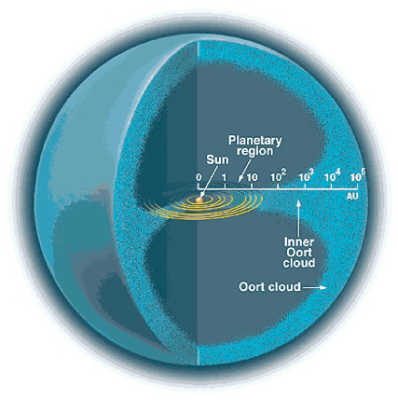
Diagram on a logarithmic scale showing the relationship between
the imagined Oort cloud of comets and the solar system.
[Click to enlarge]
|
| |
Having visualized this, Van Flandern makes the point that the true size of a sphere encompassing Pluto’s orbit is so vast that all of the 200 billion stars in our galaxy would fit with room to spare in that volume. He writes, “But the volume enclosed by the comet cloud is a billion times greater yet. It truly is unimaginably large, surviving as a plausible idea in large part because our intuitions fail so miserably to comprehend the vastness of this volume.”
But the imagined Oort cloud is needed to save a cosmological theory. And even so, it leaves vast discrepancies between the theory and things that are observed. The model itself implies that a significant percentage of comets will be on ‘hyperbolic’ orbits and launched out of the solar system by the Sun’s gravity. But this is not observed. Conversely, the observed number of short-period comets (with periods of revolution less than 200 years) is two orders of magnitude more than the Oort cloud model would predict.
Comet Theory in Crisis [ Permalink ]
Scientists at the end of the nineteenth century could see the many parallels between the behavior of a luminous comet and a laboratory glow discharge (see information panel p. 87). It was even acknowledged that the acceleration of the comet tail away from the Sun requires an electrified Sun. But in the following decades that vision was abandoned. What happened to allow this promising idea to founder, to be replaced with an inert mechanical model of a comet?
The answer seems clear—an understanding of the plasma environment in space was lacking at that time. Irving Langmuir did not coin the word ‘plasma’ until 1927. So early electrical theories of
Page 90:
comets were based on unworkable electrostatic arguments. The idea of electricity in space quickly became anathema to astronomers.
With the space age discovery of the solar ‘wind’ of charged particles, however, astrophysicists would have been wise to revisit the physics of gas discharges. Instead, they switched from the 19th century view of space as a perfectly insulating vacuum to the polar opposite, where space plasma was treated as a perfect conductor, trapping magnetic fields and preventing voltage differences between bodies in space. This turn, according to Alfvén, amounted to ‘pseudo-science’ and would lead to a crisis in astrophysics.94 That alarm was raised more than 3 decades ago. It has been ignored to this day and the crisis is now upon us.
Under the spell of theoretical assumptions, and lacking the training to recognize electrical discharge phenomena in space, astrophysicists explain comet behavior in terms of electrically neutral ‘magnetohydrodynamics.’ In other words, ‘winds’ and ‘supersonic shocks’ in electrically conducting, magnetized gas. They have ignored Alfvén’s warning that magnetic fields cannot be ‘frozen in’ to the diffuse plasma of the solar wind and the comet’s coma and tail. They are unaware that a source of electrical energy is required to produce and sustain cometary phenomena.
|
| |
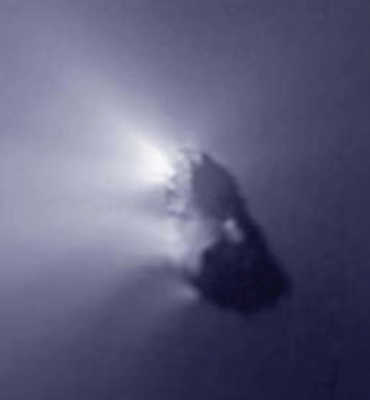
The nucleus of comet Halley as seen by the Giotto space probe.
Credit: ESA/MPAE
[Click to enlarge]
|
| |
Consequently, the electric discharge model was not even on the table at the beginning of the space age, allowing astronomers to embrace Whipple’s dirty snowball model as the scientific consensus. An endless series of surprises followed, as when cometologists caught their first close-up look at Halley [above]:“a surprising result of the Giotto and Vega spacecraft encounters with Comet Halley in March 1986 was the discovery of a shell-like region of high plasma density...” But Alfvén wasn’t surprised. He had earlier written, “It is legitimate to conclude that space in general has a ‘cellular structure,’ although this is almost impossible to observe unless a spacecraft penetrates the ‘cell walls’ (current sheets).” 95 In the approach to Halley, the spacecraft had penetrated the comet’s plasma cell wall, encountering a region whose stability and longevity could not be explained in terms of simple out-gassing from the comet.
Now, after four close flybys by spacecraft and one impact event, comets are more of an enigma than ever for astronomers. On July 4, 2005, the world watched NASA astronomers on television gleefully celebrating the Deep Impact mission’s direct hit on comet Tempel 1. But later, when the cameras had gone, the astronomers were left scratching their heads in confusion. The Deep Impact team had hoped that the impactor would kick up a relatively small cloud of dust from
Page 91:
Tempel 1, dig a crater, and expose pristine icy material underneath. There was even some doubt amongst the Deep Impact team whether the spacecraft cameras would see any effect at all. Instead there was a puzzling initial flash followed by an incredible outburst of dust as fine as talcum powder—an effect that left every observer stunned.
The New Scientist reported, “We have now had four close encounters with comets, and every one of them has thrown astronomers onto their back foot.” 96The popular model of comets as dirty snowballs no longer fits space age discoveries.
When a theory fails to anticipate discoveries and theorists are continually surprised by new data, it is essential that the theory be questioned. Astronomers believe that by discrediting a simplistic early electrical model of comets they had dismissed all electrical models. Is this stance justified in the light of what we now know about plasma discharge phenomena? The question can be answered by comparing the dirty snowball model with a new plasma discharge model of comets.
In the accepted model, a comet is an aggregate of ice and dust evaporating in the heat of the Sun. In the electric model, a comet could be a solid rockdischarging as it plunges more deeply into the Sun's electric field. A proper comparison of the two models, however, will require attention to details, accentuating the contrast between two radically different perspectives. Systematic comparison can only highlight the contrasts in predictive ability—the test of a good theory.
|
|
References:
91 K. R. Birkeland, The Norwegian Aurora Polaris Expedition, 1902-1903, Volume 1: On the Cause of Magnetic Storms and The Origin of Terrestrial Magnetism. Published 1908.
92 H. Alfvén, Cosmic Plasma, Astrophysics and Space Library, Vol. 82, D. Reidel Publishing Co. 1981.
93 T. Van Flandern, Dark Matter, Missing Planets & New Comets, pp. 180-1.
94 H. Alfvén, "Plasma physics, space research and the origin of the solar system," Nobel Lecture, December 11, 1970, p. 308.
95 H. Alfvén, Space Plasma, 1981, p. 40.
96 S. Clark, "Comet tails of the unexpected," New Scientist, 9 September 2005.
|









